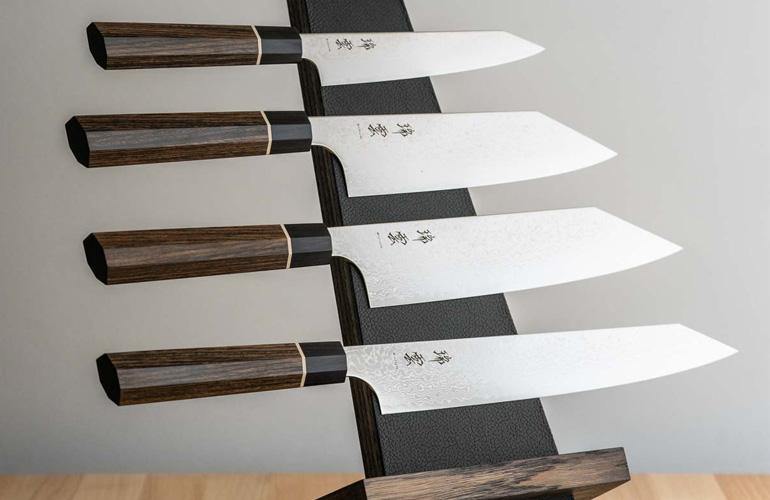
Why Japanese Knives
Why Japanese Knives Australia?
Take a dive into the wonderful world of Japanese chef knives, and why they’re considered to be the best in the world.
There is a certain romanticism associated with fine goods that are crafted by hand. Japanese chef knives are forged with precision and care, steeped in tradition, and hold quality of the finished product above all else. They hold a special place in the hearts of many.
Deep down we yearn to own something special, something that has been meticulously designed and constructed, not stamped out on an assembly line.
Yes, they can be pricey, the price reflects the caliber of the build. A high-quality knife, with the correct care, will remain are the forefront of your kitchenware for years. Not only do they make light work of dicing onions, Japanese kitchen knives have numerous design features that make them outperform almost all other kitchen knives in the world.
So what makes Japanese kitchen knives so special?
Weight
Generally speaking European knives are heavy; this is due to the ‘full tang’ design feature. The steel of full tang blades continue through to the end of the handle, as pictured below.
In some instances, the handle is also made of steel resulting in a knife which is overly heavy and cumbersome to use for long periods of time. As seen in the image below (courtesy of www.thespruceeats.com), all that extra steel in the handle adds much to the weight of the knife.
The steel of a Japanese blade quickly tapers off in size after it enters the handle reducing the overall weight of the knife. This may bring the balance of the knife to be slightly forward heavy, a trait many chefs quickly get used to in order to take advantage of the Japanese chef knives superior performance. This image below shows an average Japanese chef knife in terms of the steel quickly dropping off as it gets into the handle.
Some Japanese chef knives may feature what is called a ‘distal taper’, where the thickness of the blade increases just before it enters the handle, adding weight to the rear of the knife to bring it back into balance. This increases comfort to the user making it perfect for all day every day use.
Grind/Bevel
The ‘grind’ or ‘bevel’ refers to the shape of the blade when you look down from the handle to the tip. On the whole, European knives have a thicker, heavier blade and the cutting edge itself is a short ~ 20-degree taper that is even on both sides (50/50), about 1-2mm from the tip of the blade.
The Japanese blade will be much thinner, and the thinner the blade, the easier cuts are made, and the more agile cutting work it can perform. The cutting edge of a regular Japanese knife is much lower than 20 degrees and starts much higher on the blade. Traditional Sashimi knives like the Yanagiba or the Sujuhiki (knives designed for long pull cuts) have only a single bevel, meaning that one side is flat, and the other side tapers off at a low angle. This pushes the food away from the blade once the cut has been made.
A thinner grind, although resulting in much greater sharpness, means that a Japanese kitchen knife may be prone to chipping or breakage if used improperly (torquing/twisting the blade while cutting, or hitting or chopping hard or frozen objects). Whilst European knives can be more robust, they are made of softer steel, go blunt quicker, and can’t make as precise cuts.
For most chefs, the trade-off for much better all-round performance is worth the small level of extra care and maintenance required of Japanese kitchen knives.
Exotic Steels
While many European knives will be made from some form of softer stainless steel, most Japanese knives employ the use of high-carbon steel combined with extra elements (nickel, chromium, vanadium, tungsten, molybdenum) to produce exotic alloys that have greatly enhanced corrosion resistance, hardness, and durability.
A Japanese traditional high-carbon steel such as Aogami Super (Blue Paper Steel) or Shirogami Steel (White Paper Steel) will not have the corrosion resistance of their stainless counterparts, and as such will need extra care and maintenance and can be reactive to certain foods, developing a multicoloured hue on the blade known as a ‘patina’.
It is common for Japanese knives to be crafted with a technique called ‘San-Mai’, by which a very hard cutting edge of reactive, high-carbon steel is sandwiched between 2 external layers of softer stainless steel. This guarantees fantastic cutting performance and an easy to maintain blade.
Hardness
Steel hardness can be graded by the Rockwell hardness scale. Softer steels such as Cromova can only be hardened to 54-56 which is considered quite low. These knives can take more punishment, and are less brittle, but will go blunt extremely quickly due to their softness.
Japanese knives are normally anywhere between 61-67 HRC, giving them their legendary edge retention and long lasting sharpness. This comes at a price, however, with extreme hardness comes the risk of chipping and damaging the blade from improper use as described above.
Tradition and Care
The Japanese consistently strive towards excellence in their craft, as is the age-old philosophy so widespread in Japanese culture. Individual Blacksmiths will always be creatively exploring ways to refine their processes and push the boundaries of what is possible in knifemaking, whilst preserving the traditions that have been passed on throughout generations.
Their aim is to ensure that every blade is as carefully and meticulously crafted to the same quality as the last and that the lust for Japanese kitchen knives, the finest in the world, continues for many more generations to come.
